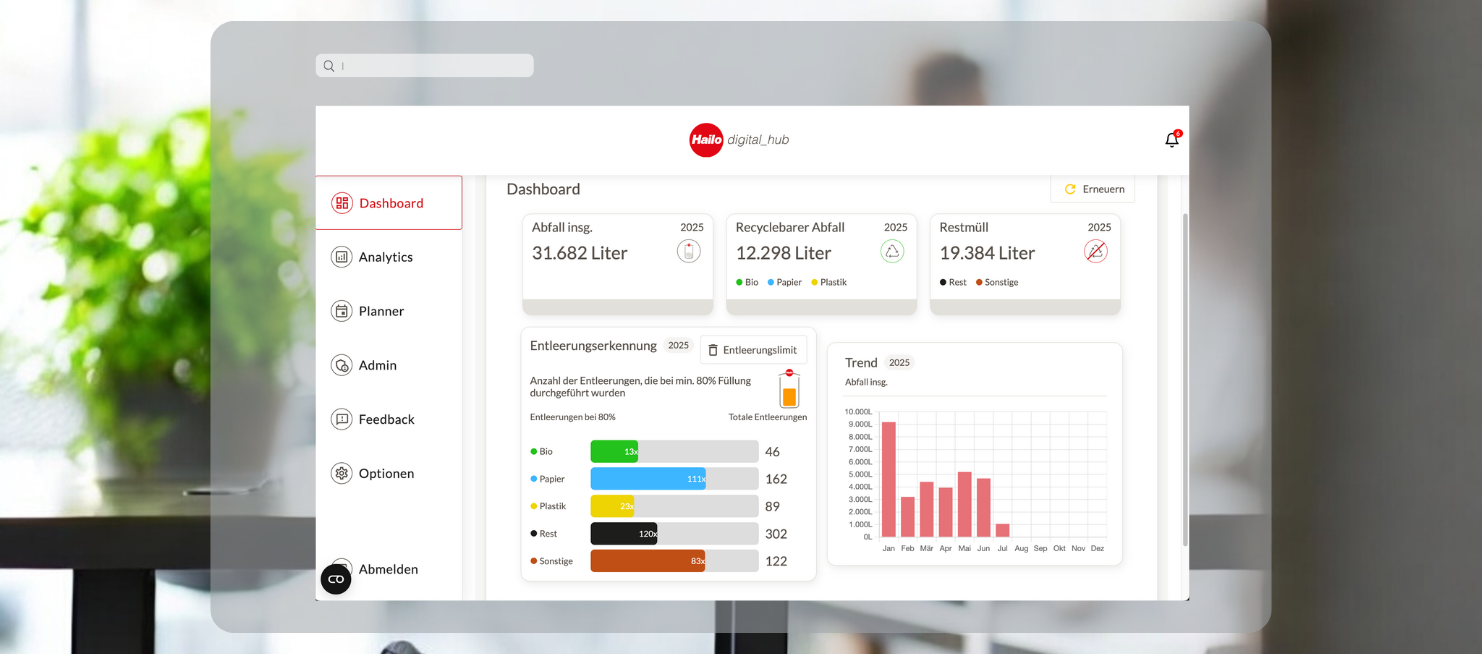Fill-Level Sensors for Waste Bins – IoT Technology Revolutionizing Waste emptying
From Rigid Collection Schedules to Smart Sensors
Traditional facility cleaning often relies on fixed schedules for emptying bins regardless of their actual fill status. This inflexible approach leads to inefficiencies: half-empty bins are unnecessarily emptied while full bins can be overlooked. The result: wasted trips, time, and money.
Fill-level sensors fundamentally address this problem. IoT-enabled sensors continuously monitor each bin's fill level, enabling demand-driven collection. Instead of routinely checking every bin, cleaning teams now know exactly where action is needed thanks to real-time data. No more on-site checks—sensors provide this information remotely. Fixed collection rounds are replaced by flexible, needs-based scheduling.
How Modern Fill-Level Sensors Work
Fill-level sensors are the technical core of every Smart Waste Solution. Typically using ultrasonic or infrared technology, these devices measure the distance from the sensor to the waste surface to calculate the bin's fill percentage. Built to withstand harsh conditions inside bins, these sensors tolerate temperature fluctuations, humidity, and vibrations. Many models are battery-powered with ultra-low energy consumption, allowing years of maintenance-free operation.
The collected data is sent via a radio module at fixed intervals or during specific events (e.g. reaching a threshold of 80% filling). Here comes that Internet of Things In play: Techniques such as LoRaWAN, Sigfox or mobile communications (LTE/NB-IoT) ensure that the measured values also reach the cloud from underground car parks or remote parts of buildings. There, they are displayed in real time on the dashboard (more about this in the article “Digital waste management with dashboard — using data effectively”) and can be evaluated by those responsible.
Advanced sensors can do more: Some detect waste types or special conditions. Hailo digital_hub Uses sensors that regularly measure fill levels, providing significant practical advantages. This allows cleaning teams to know precisely when a bin has reached its optimal fill point.
Practical Implementation
Smart fill-level sensors can be easily retrofitted. Existing bins do not need replacement sensors are mounted inside lids or bin walls and activated. Their compact design minimizes intrusion and preserves capacity.
Once installed, sensors immediately start transmitting data. Facility Managers and Cleaning Staff can view fill levels for all bins via a central dashboard (web or app). For example, a supervisor's tablet might show that bins on floor 5 are 90% full, while conference room bins remain almost empty allowing optimized cleaning routes.
A key benefit are real-time alerts: If a bin reaches a critical fill level or an unusual surge occurs, the system automatically sends a notification, ensuring timely response and preventing overflows.
Benefits in Practice
The introduction of fill level sensors in waste bins is having an immediate effect:
Optimized Route Planning:
Cleaning teams empty bins only when necessary, reducing travel distances and fuel consumption a win for budgets and the environment.
Reduced Personnel Effort
Manual inspections become obsolete, freeing staff for more productive tasks. Experience shows up to 80% reduction in emptying efforts.
Transparency and Accountability
Every emptying event is digitally recorded, providing verifiable service records that build trust and allow service providers to document their performance accurately.
Higher Employee Satisfaction
Eliminating monotonous inspection rounds makes work more varied and less physically demanding, improving morale and motivation.
Fill-level sensors are central to facility Cleaning 4.0, demonstrating how digitalization and IoT dramatically improve even traditionally manual tasks. For further details on savings and ROI, see our article “Building cleaning 4.0 - How sensor-based waste management reduces costs and optimizes processes".
Conclusion
IoT fill-level sensors have revolutionized corporate waste management. They enable proactive, data-driven collection tailored to actual needs delivering more control, less effort, and tangible environmental benefits. In short, smart sensors transform an ordinary waste bin into an intelligent helper for efficient, sustainable facility management.
Ready to upgrade your bins with intelligent fill-level sensors and start realizing the benefits? Contact us today Hailo digital_hub wants to advise you on retrofitting and integrating Smart Waste Sensors in your facilities.










